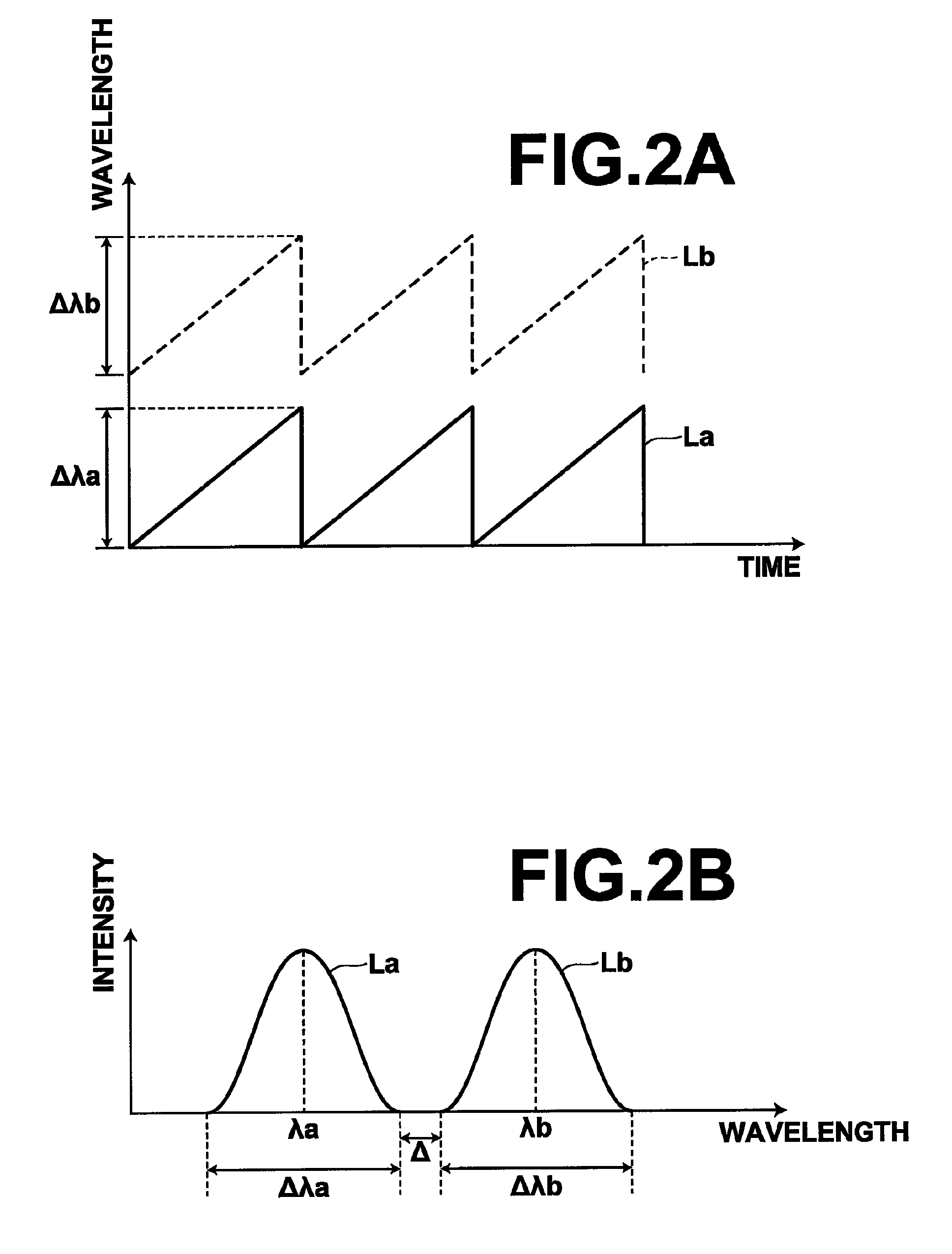Optical tomograph using a plurality of wavelength-swept light beams
a technology of optical tomograph and light beam, which is applied in the field of optical tomograph, can solve the problems of reducing productivity, increasing cost, and limited number of data points, and achieves the effects of reducing constraints placed on optical tomograph, simplifying apparatus structure, and improving resolution of obtained tomographic images
- Summary
- Abstract
- Description
- Claims
- Application Information
AI Technical Summary
Benefits of technology
Problems solved by technology
Method used
Image
Examples
first embodiment
[0056]Hereinafter, optical tomographs according to preferred embodiments of the present invention will be described in detail with reference to the attached drawings. FIG. 1 is a diagram that illustrates the schematic construction of an optical tomograph 1 according to the present invention. The optical tomograph 1 obtains tomographic images of measurement targets such as tissue within body cavities or cells by SS-OCT measurement, using a Mach-Zehnder type interferometer.
[0057]The optical tomograph 1 comprises: a light source unit 10 for emitting light beams La and Lb, the wavelengths of each of which are periodically swept within different predetermined wavelength bands respectively; light dividing means 3a and 3b for respectively dividing the light beams La and Lb into measuring light beams L1a, L1b and reference light beams L2a, L2b; combining means 4a and 4b for combining reflected light beams L3a, L3b, which are the measuring light beams L1a and L1b reflected by a measurement t...
second embodiment
[0097]Hereinafter, an optical tomograph 200 according to the present invention will be described with reference to FIG. 7, FIG. 8A, and FIG. 8B. FIG. 7 is a diagram that illustrates the schematic construction of the optical tomograph 200. Note that in FIG. 7, components of the optical tomograph 200 which are the same as those of the optical tomograph 100 of FIG. 1 are denoted with the same reference numerals, and that detailed descriptions thereof will be omitted, insofar as they are not particularly necessary. The optical tomograph 200 of FIG. 7 differs from the optical tomograph 100 of FIG. 1 in the wavelength bands of the light beams LSa and LSb emitted by the light source 10, and in that optical filters 201a and 201b are provided. Hereinafter, a description will be given mainly regarding the differences between the optical tomograph 200 and the optical tomograph 100.
[0098]The wavelengths of the light beams LSa and LSb emitted by the light source unit 10 of the optical tomograph ...
third embodiment
[0110]Next, an optical tomograph 300 according to the present invention will be described with reference to FIG. 9. FIG. 9 is a diagram that illustrates the schematic construction of the optical tomograph 300. Note that in FIG. 9, components of the optical tomograph 300 which are the same as those of the optical tomograph 100 of FIG. 1 are denoted with the same reference numerals, and that detailed descriptions thereof will be omitted, insofar as they are not particularly necessary. The optical tomograph 300 is an SS-OCT apparatus that employs a Mach-Zehnder interferometer. The optical tomograph 300 differs from the optical tomograph 100 in that the combining / dividing means 5 is provided upstream of the interferometer. Hereinafter, a description will be given mainly regarding the differences between the optical tomograph 300 and the optical tomograph 100.
[0111]In the optical tomograph 300, the light beam La emitted by the light source 10a propagates through the optical fiber FB1a, a...
PUM
 Login to View More
Login to View More Abstract
Description
Claims
Application Information
 Login to View More
Login to View More - R&D
- Intellectual Property
- Life Sciences
- Materials
- Tech Scout
- Unparalleled Data Quality
- Higher Quality Content
- 60% Fewer Hallucinations
Browse by: Latest US Patents, China's latest patents, Technical Efficacy Thesaurus, Application Domain, Technology Topic, Popular Technical Reports.
© 2025 PatSnap. All rights reserved.Legal|Privacy policy|Modern Slavery Act Transparency Statement|Sitemap|About US| Contact US: help@patsnap.com



